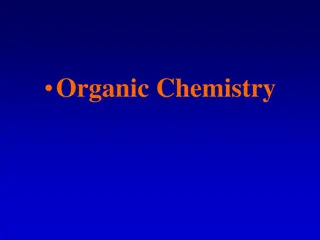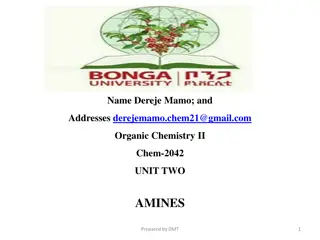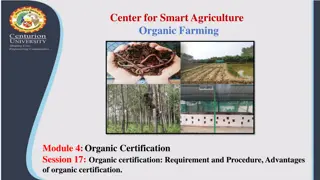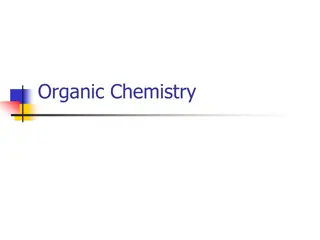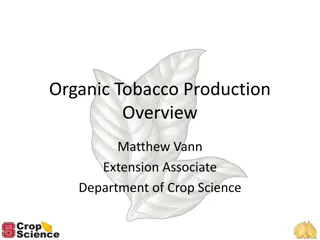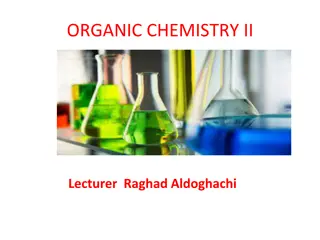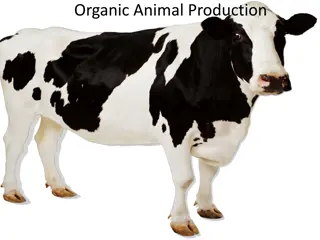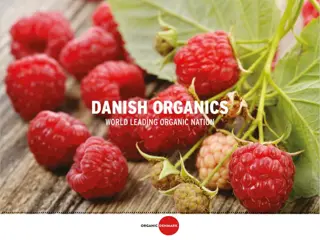Exploring Organic Chemistry Fundamentals
Delve into the world of organic chemistry, understanding the nature of organic compounds, the unique attributes of carbon, and the properties of these compounds. Discover the significance of molecular, structural, and condensed formulas, along with insights into hydrocarbons and the concept of homologous series.
Download Presentation

Please find below an Image/Link to download the presentation.
The content on the website is provided AS IS for your information and personal use only. It may not be sold, licensed, or shared on other websites without obtaining consent from the author. Download presentation by click this link. If you encounter any issues during the download, it is possible that the publisher has removed the file from their server.
E N D
Presentation Transcript
Unit 13 ORGANIC CHEMISTRY
Aim #1 What is an organic compound and what are its properties ? Organic chemistry is the study of carbon and its compounds found in fossil fuels, plants, animals Examples include: gasoline, oil, sugars Hydrocarbon contains only the elements H & C (TABLE Q) Therefore, hydrocarbons are organic, but not all organic compounds are hydrocarbons
Why is carbon so special? Has 4 valence electrons, so it can bond 4 times to achieve a stable octet
1. Nonelectrolytes (do not conduct electricity) 2. React slowly because they are covalent (nonmetal + nonmetal) 3. Usually low melting point and boiling point 4. Insoluble and immiscible in water PROPERTIES OF ORGANIC COMPOUNDS
1. Which of the following are organic? 2. Which of the following are hydrocarbons?
Types of Chemical Formulas Molecular Formula- shows the # of atoms of each element in a compound (least informative formula) Ex. Propane = C3H8
Types of Chemical Formulas Structural Formula- shows the number of atoms of each element AND the arrangement of the atoms; most informative formula Ex. Propane =
Types of Chemical Formulas Condensed/Collapsed Formula- combination of both structural and molecular formulas -each carbon is written with its constituent hydrogens followed by the proper subscript Ex. Propane = CH3CH2CH3
Structural Formula Condensed Formula CH3C2CH3
HOMOLOGOUS SERIES Table Q shows the general formulas and structures for 3 families of hydrocarbons
1. Alkanes- single bonded hydrocarbons contains ONLY (C-C) These bonds are considered saturated. They have the maximum number of hydrogens attached. Remember that each bond represents 1 pair of shared electrons (2 e- total per bond) General formula: CnH2n+2 Example: Methane
2. Alkenes- double bonded hydrocarbons, contains (C=C) These bonds are considered unsaturated General formula: CnH2n Example: Butene
3. Alkynes triple bonded hydrocarbons, contains (C- C triple bonds) These bonds are considered unsaturated General formula CnH2n-2 Example: Propyne
How can we name hydrocarbons? - IUPAC To name simple hydrocarbons (straight chain, only C and H), we will put information from Table P and Table Q together Table P shows the prefix to determine how many carbons are in a compound Ex) Give the prefixes for the following: C2H6 C4H6 C5H12 C7H14 C8H18 C10H20
How can we name hydrocarbons? - IUPAC Steps in naming simple (unbranched) hydrocarbons: 1. How many carbon atoms are in the longest continuous chain? Find the prefix for this from Table P. 2. If it is an alkane, simply add the suffix -ane to the name.
How can we name hydrocarbons? - IUPAC 3. If it is an alkene, you must first indicate the location of the double bond(s) if the molecule has more than 3 Cs. Do this by numbering the carbons on the chain and stating the lowest carbon # where the double bond is located. Then add the suffix -ene to the name.
How can we name hydrocarbons? - IUPAC 4. If it is an alkyne, you must first indicate the location of the triple bond(s) if the molecule has more than 3 Cs. Do this by numbering the carbons on the chain and stating the lowest carbon # where the triple bond is located. Then add the suffix -yne to the name.
Aim # 3 What are isomers? Isomers have the same molecular formula but are rearranged in a different structure with different chemical and physical properties. At least 4 carbons must be present in a molecule to have isomers Methane, ethane, and propane DO NOT have any isomers
What are isomers? Butane is the first molecule to have isomers. The larger the molecule (the more carbon atoms), the more isomers the molecule will have 3 ways to make an isomer: 1. Make a branch (on a non-terminal carbon) 2. Move a branch 3. Move a multiple bond (a double or triple bond)
What are isomers? Pentane Isomers
What are isomers? Pentene Isomers
Aim # 4 How can we name & draw substituted hydrocarbons? Count the longest parent chain of carbon atoms name that chain Scan the chain and take note of anything that is not a C or H Indicate the lowest number carbon that has the substitution Name the substitution (F-fluoro, Cl-chloro, Br- bromo, I- iodo, CH3- methyl, CH2 - ethyl) Notice that if there are more than one substitutions, you must indicate all of their locations (which # C they re attached to), and put a numerical prefix in front of the substitution name ( di- for 2, tri- for 3, tetra- for 4) 1. 2. 3. 4.
How can we name and draw substituted hydrocarbons? chloromethane
How can we name and draw substituted hydrocarbons? dichloromethane
How can we name and draw substituted hydrocarbons? F H H - C C H H H 1-fluoroethane
How can we name and draw substituted hydrocarbons? 1,1 -difluoroethane
How can we name and draw substituted hydrocarbons? F H H - C C H H F 1,2 - difluoroethane
How can we name and draw substituted hydrocarbons? 1-fluoro, 1,2 dibromo ethane
How can we name and draw substituted hydrocarbons? 1,2 dichloropropane
How can we name and draw substituted hydrocarbons? 1,3 - dicholoropropane
How can we name and draw substituted hydrocarbons? 2-methylpropane
How can we name and draw substituted hydrocarbons? 2,2 dimethyl butane
How can we name and draw substituted hydrocarbons? 2, 2, 3 trimethyl pentane
Aim # 5 What are functional groups? Although hydrocarbons are the most basic organic compounds, many other organic compounds form when other atoms replace one or more hydrogen atoms in a hydrocarbon These atoms or groups of atoms, called functional groups, replace hydrogen atoms in a hydrocarbon and give the compound distinctive physical and chemical properties The naming of these compounds is made easy because they derive their names from the hydrocarbon with the corresponding number of carbon atoms
Halides- Have one of the halogens as a branched group F (fluoro) Cl (chloro) Br (bromo) I (iodo)
Chloromethane Fluoromethane 1, 2 dibromo ethane
Alcohols a) Have an OH group b) Flammable, soluble c) NOT bases (covalently bonded) and NOT electrolytes d) Has the suffix -ol and must also state the location of the OH along the carbon chain (using lowest # location)
Organic Acids a) Have a carboxyl group (-COOH) at the last carbon b) Also known as carboxylic acids: weak acids/weak electrolytes because they generate H+ ions in solution c) Has the suffix -oic acid
Aldehydes a) CHO group found at the end of the hydrocarbon chain b) Soluble and reactive c) Has the suffix -al
Ketones a) CO group located on an interior carbon atom a) Can NEVER be a terminal carbon, or it would be an aldehyde! b) Has the suffix -one c) Somewhat soluble, needs at least 3 carbons
Ester a) Contains COO connecting parent chain to branch a) Smell nice! Found in perfumes, foods b) Has the suffix -anoate
Amine a) Nitrogen is present b) Used in dyes, found in proteins, DNA c) Has the suffix -amine
Amide a)Contains b)Used in dyes c)Has the suffix -amide propanamide
Ether Dimethyl ether a) look for O- somewhere in the middle b) anesthetic, soluble c) Name small chain, then the large chain and follow with suffix -ether Methyl ethyl ether
Aromatic Hydrocarbons a) 6 carbons are in a closed ring with alternating double and single bonds b) Called benzene c) It is very stable d) Can be substituted Methylbenzene 1,4-dichloro benzene
Aim # 6 What are the different organic reactions?
1. Combustion a) In the presence of oxygen: A hydrocarbon and oxygen produces CO2 and water In limited oxygen: A hydrocarbon and oxygen produce CO and Water





